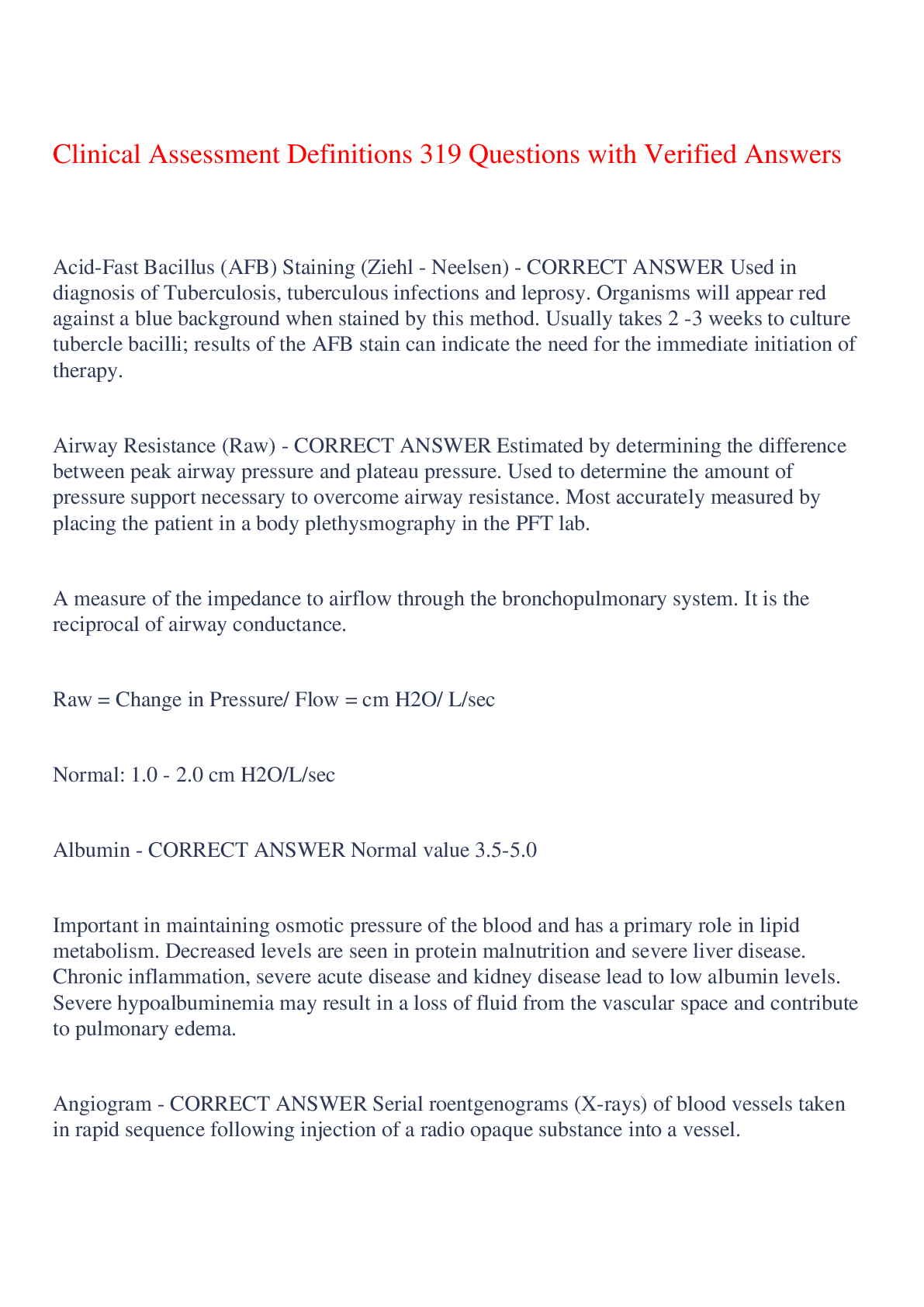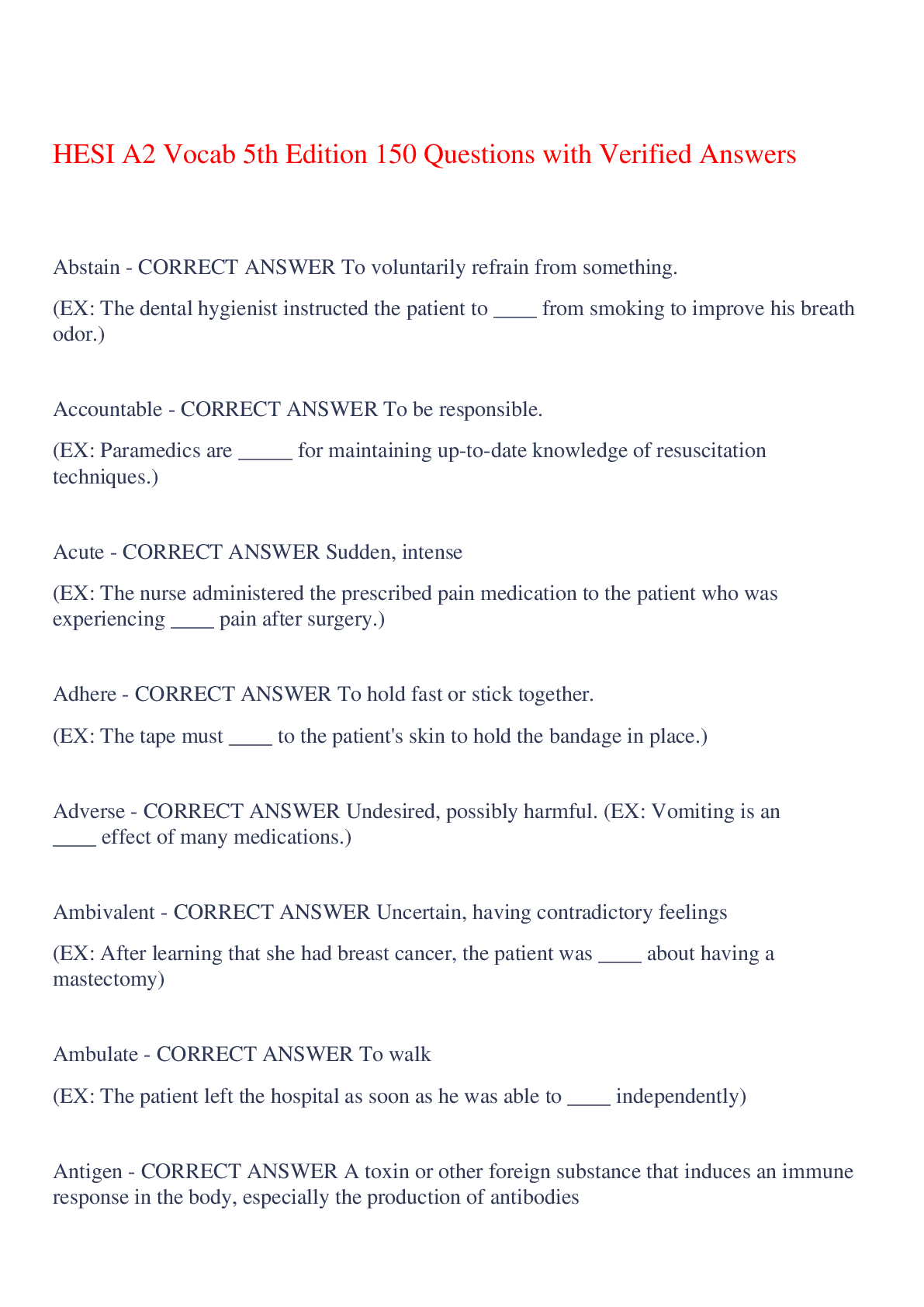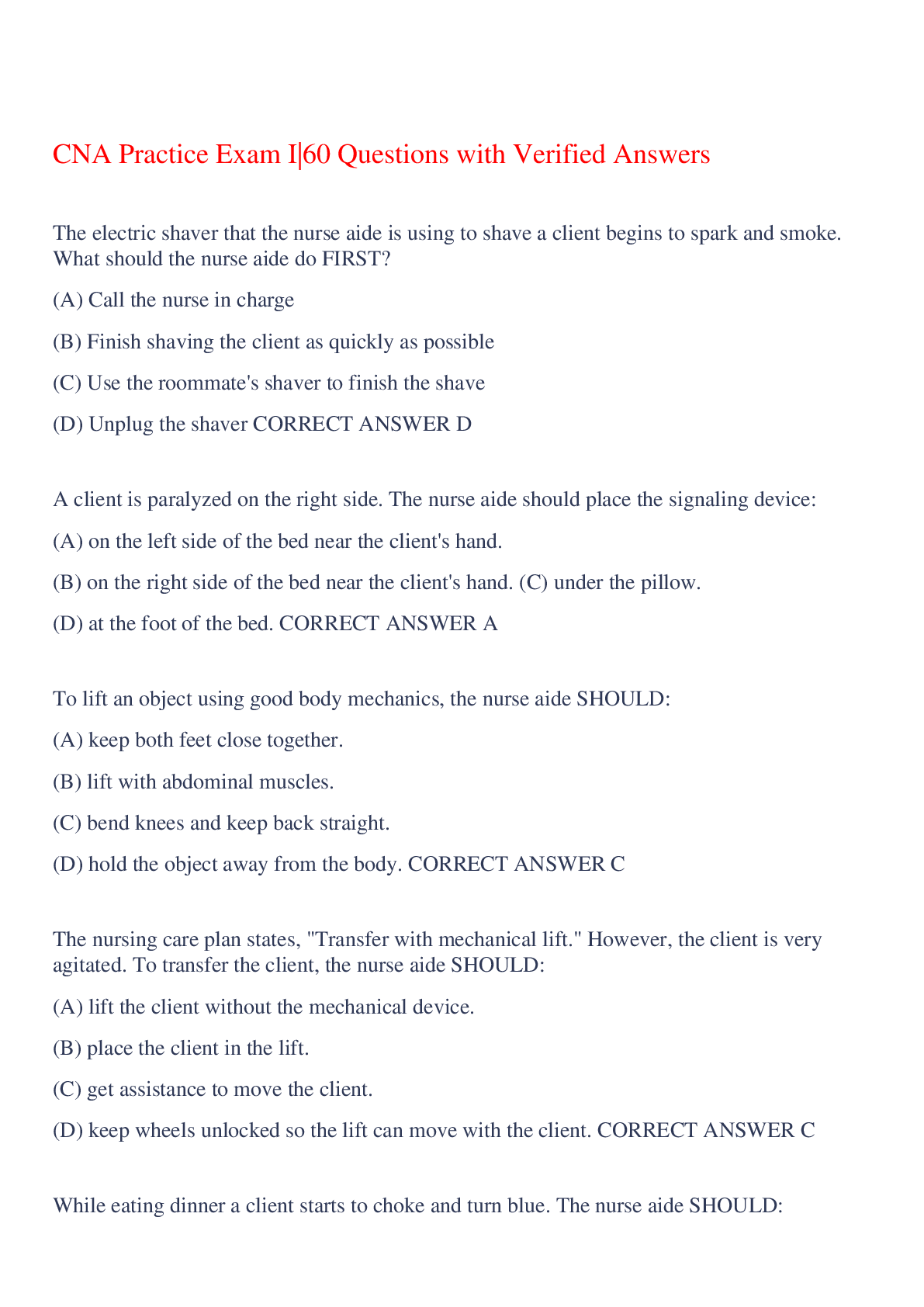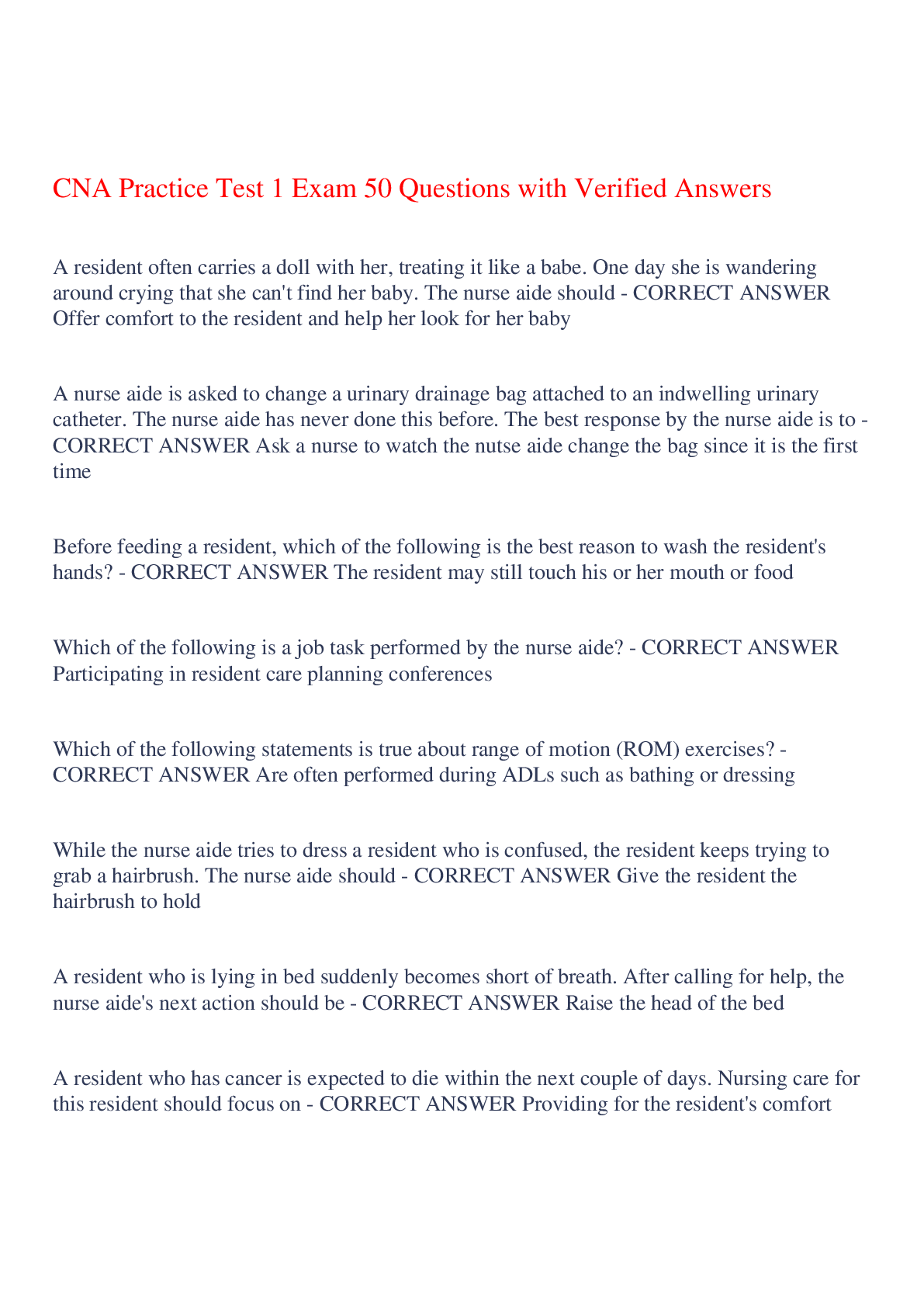Health Care > EXAM > NFPA 10 Standards for Portable Fire Extinguishers (Part 1) 74 Questions with Verified Answers,100% C (All)
NFPA 10 Standards for Portable Fire Extinguishers (Part 1) 74 Questions with Verified Answers,100% CORRECT
Document Content and Description Below
NFPA 10 Standards for Portable Fire Extinguishers (Part 1) 74 Questions with Verified Answers What is the scope of the NFPA 10 (what does it deal with and pertain to)? (1.1) - CORRECT ANSWER Appl... ies to the selection, installation, inspection, maintenance, recharging, and testing of portable fire extinguishers and class D extinguishing agents What is the units of Measurement used? (1.3) - CORRECT ANSWER metric Define: Authority Having Jurisdiction - CORRECT ANSWER (AHJ) An organization, office, or individual responsible for enforcing the requirements of a code or standard, or for approving equipment, materials, an installation, or a procedure (such as fire chief, fire marshall) Define: Shall (3.2.5) - CORRECT ANSWER indicates mandatory requirement Define: Should (3.2.6) - CORRECT ANSWER Indicates a recommendation What does ANSI stand for?(3.3.1) - CORRECT ANSWER American National Standards Institute Define: Carbon Dioxide (3.3.3) - CORRECT ANSWER A colorless, odorless, electrically nonconductive inert gas that is a suitable medium for extinguishing Class B and Class C fires. How does Carbon Dioxide extinguish fire? (A 3.3.3) - CORRECT ANSWER Liquid carbon dioxide forms dry ice when released directly into the atmosphere. Carbon dioxide extinguishes fire by reducing the concentrations of oxygen, the vapor phase of the fuel, or both in the air to the point where combustion stops. What is a Dry Chemical?(3.3.4.1) - CORRECT ANSWER A powder composed of very small particles, usually sodium bicarbonate-,potassium bicarbonate-, or ammonium phosphate based with added particulate material supplemented by special treatment to provide resistance to packing, resistance to moisture absorption (caking), and the proper flow capabilities What is a Wet Chemical? (3.3.4.2) - CORRECT ANSWER Normally an aqueous solution of organic or inorganic salts or a combination thereof that forms an extinguishing agent What is a Clean Agent?(3.3.5) - CORRECT ANSWER A fire suppression agent that does not leave any residue after use or interfere with the operation of electrical or electronic equipment. What is a Dry Chemical Closed Recovery System ?(3.3.6.1) - CORRECT ANSWER A system that is constructed in a manner that does not introduce foreign material into the agent being recovered and has a means of visually inspecting the recovered agent for contaminants Halogenated Closed Recovery System (3.3.6.2) - CORRECT ANSWER A system that provides for the transfer of halogenated agents between fire extinguishers, supply containers, and recharge and recovery containers so that none of the halogenated agent escapes to the atmosphere. The system's supply or recharge and recovery container is capable of maintaining the agent in a sealed environment until it is reused or returned to the agent manufacturer. Define: High Pressure cylinders (3.3.7.1) - CORRECT ANSWER Cylinders (and cartridges) containing nitrogen, compressed air, carbon dioxide, or other gases at a pressure higher than 500 psi at 70 degrees F Define: Low Pressure cylinders (3.3.7.2) - CORRECT ANSWER Cylinders (and cartridges) containing nitrogen, compressed air, carbon dioxide, or other gases at a pressure of 500 psi or lower at 70 degrees F What is Dry Powder? (3.3.9) - CORRECT ANSWER Solid materials in powder or granular form designed to extinguish Class D combustible metal fires by crusting, smothering, or heat-transferring means What is electronic monitoring of a fire system? (3.3.10) - CORRECT ANSWER either a local alarm device to indicate when an extinguisher is removed from its designated location or a method of electronic communication between in place extinguisher and electronic monitoring device What is an Extinguisher Bracket and why is it used? (3.3.11) - CORRECT ANSWER Extinguisher retention device designed to mount and secure a specific Extinguisher model onto various surfaces by incorporating releasable straps or bands to secure the fire extinguisher What is an Extinguisher cabinet and why is it used? (3.3.12) - CORRECT ANSWER An identifiable and readily accessible fire extinguisher housing device designed to store and protect fire equipment What is an Extinguisher Hanger and why is it used? (3.3.13) - CORRECT ANSWER Extinguisher mounting device designed for mounting a specific extinguisher model onto stationary vertical surfaces Extinguisher Inspection (3.3.14) - CORRECT ANSWER A quick check that a fire extinguisher is in it's designated place, that it has not been actuated or tampered with, and that there is no obvious physical damage or condition to prevent its operation. Intended to give reasonable assurance that the fire extinguisher is fully charged. Extinguisher maintenance (3.3.15) - CORRECT ANSWER A thorough examination of the fire extinguisher that is intended to give maximum assurance that a fire extinguisher will operate effectively and safely, to determine if physical damage or condition will prevent its operation, if any repair or replacement is necessary, and if hydrostatic testing or internal maintenance is required Film-Forming Foam (3.3.16) - CORRECT ANSWER A solution that will form an aqueous film on liquid fuels Aqueous - CORRECT ANSWER of or containing water, typically as a solvent or medium. like water; watery. "a great hall of aqueous marble" What does AFFF stand for? (3.3.16.1) - CORRECT ANSWER Aqueous Film Forming Foam What is Aqueous Film Forming Foam (AFFF)? (3.3.16.1) - CORRECT ANSWER A water-based extinguishing agent that forms a foam layer over the liquid and stops the production of flammable vapors. Based on fluorinated surfactants plus foam stabilizers used on Class B fires What does FFFP Stand for? (3.3.16.2) - CORRECT ANSWER Film Forming Fluoroprotein Foam What is Film Forming Fluoroprotein Foam (FFFP) (3.3.16.2) - CORRECT ANSWER Foam concentrate that, in addition to the air excluding foam blanket, can deposit a vaporization-preventing film on the surface of the liquid fuel. Combines the qualities of fluoroprotein foam with those of aqueous film forming foam for suppressing liquid fuel vapors. Flammable liquids of Appreciable Depths (3.3.17) - CORRECT ANSWER those with a depth greater than 1/4 inch Halocarbons (3.3.18.1) - CORRECT ANSWER Include HCFC, HFC, PFC, FIC types of agents and other halocarbons that are found acceptable under the new Environmental Protection Agency Significant New Alternative Program Halons (3.3.18.2) - CORRECT ANSWER any of a number of unreactive gaseous compounds of carbon with bromine and other halogens, used in fire extinguishers, but now known to damage the ozone layer. HMIS - CORRECT ANSWER Hazardous Material Identification System Hydrostatic Testing (3.3.19) - CORRECT ANSWER Pressure testing of the extinguisher to verify its strength against unwanted rupture. Loaded Stream Charge (3.3.20) - CORRECT ANSWER A water-based extinguishing agent that uses an Alkali metal salt as a freezing point depressant Mild Steel Shell (3.3.21) - CORRECT ANSWER All steel shells other than stainless steel and steel shells used for high pressure cylinders Extinguisher Service Pressure (3.3.22.1) - CORRECT ANSWER The normal operating pressure as indicated on the nameplate or cylinder of a fire extinguisher Factory Test Pressure (3.3.22.2) - CORRECT ANSWER The pressure shown on the nameplate at which a shell was tested at time of manufacture. Pressurized flammable liquid fires (3.3.23) - CORRECT ANSWER Fires resulting from liquids that are forced, pumped, or sprayed. recharging (3.3.24) - CORRECT ANSWER The replacement of the extinguishing agent (also includes the expellant for certain types of fire extinguishers) servicing (3.3.25) - CORRECT ANSWER performing maintenance, recharging, or hydrostatic testing on a fire extinguisher TC (3.3.26) - CORRECT ANSWER Transport Canada: Has jursidiction over high and low pressure cylinders and cartridges in Canada DOT (3.3.8) - CORRECT ANSWER Department of Transportation Wetting Agent (3.3.28) - CORRECT ANSWER a concentrate that, when added to water, reduces the surface tension and makes it more effective in spreading over and penetrating surfaces. Cartridge / cylinder operated fire extinguisher (3.4.1) - CORRECT ANSWER A fire extinguisher in which the expellant gas is in a separate container from the agent storage container. non-rechargeable (nonrefillable) fire extinguishers (3.4.2) - CORRECT ANSWER A fire extinguisher that is intended to be used one time and not capable of or intended to be recharged and returned to service Portable fire extinguishers (3.4.3) - CORRECT ANSWER A portable device, carried or on wheels and operated by hand, containing an extinguishing agent that can be expelled under pressure for the purpose of extinguishing fire Rechargeable (Refillable) Fire Extinguisher (3.4.4) - CORRECT ANSWER A fire extinguisher capable of undergoing complete maintenance, including internal inspection of the pressure vessel, replacement of of all substandard parts and seals, and hydrostatic testing Self-expelling fire extinguisher (3.4.5) - CORRECT ANSWER A fire extinguisher in which the agents have sufficient vapor pressure at normal operating temperatures to expel themselves. Stored-pressure fire extinguisher (3.4.6) - CORRECT ANSWER A fire extinguisher in which both the extinguishing agent and the expellant gas are kept in a single container, and that includes a pressure indicator or gauge. Water Mist Fire Extinguisher (3.4.7) - CORRECT ANSWER A fire extinguisher containing distilled or de-ionized water and employing a nozzle that discharges the agent in a fine spray Water type fire extinguisher (3.4.8) - CORRECT ANSWER A fire extinguisher containing water-based agents, such as water, AFFF, FFFP, antifreeze, loaded stream, and wet chemical. Wheeled fire extinguisher (3.4.9) - CORRECT ANSWER A portable fire extinguisher equipped with a carriage and wheels that is intended to be transported to the fire by one person. What manufacturer contents should identifiable on the on a fire extinguisher label/tag? (4.2) - CORRECT ANSWER (1) The content's product name as it appears on the manufacturer's Material Safety Data Sheet (MSDS) (2) Listing of the hazardous material identification in accordance with Hazardous Materials Identification System (HMIS), Implementation Manual (3) List of any hazardous materials that are in excess of 1.0 percent of the contents (4) List of each chemical in excess of 5.0 percent of the contents (5) Information as to what is hazardous about the agent in accordance with the MSDS (6) Manufacturer's or service agency's name, mailing address, and phone number Obsolete Fire Extinguishers (4.4) - CORRECT ANSWER (1) Soda acid (2) Chemical foam (excluding film-forming agents) (3) Vaporizing liquid (e.g., carbon tetrachloride) (4) Cartridge-operated water (5) Cartridge-operated loaded stream (6) Copper or brass shell (excluding pump tanks) joined bysoft solder or rivets (7) Carbon dioxide extinguishers with metal horns (8) Solid charge-type AFFF extinguishers (paper cartridge) (9) Pressurized water fire extinguishers manufactured priorto 1971 (10) Any extinguisher that needs to be inverted to operate (11) Any stored pressure extinguisher manufactured prior to1955 (12) Any extinguishers with 4B, 6B, 8B, 12B, and 16B fire ratings (13) Stored-pressure water extinguishers with fiberglass shells (pre-1976) Dry chemical storage date that must be removed from service (4.4.1) - CORRECT ANSWER 1984 or prior What are the general requirements to determine the type of fire extinguisher for a given situation? (5.1) - CORRECT ANSWER (1) Type of fire most likely to occur (2) Size of fire most likely to occur (3) Hazards in the area where the fire is most likely to occur (4) Energized electrical equipment in the vicinity of the fire (5) Ambient temperature conditions *Additional info in Anex C.1.1 Are the selection of fire extinguishers dependent on the other fire protection methods the area is equipped with? (5.1.2) - CORRECT ANSWER No. They are installed as a first line of defense Class A fires involve what type of fuel source? (5.2.1) - CORRECT ANSWER ordinary combustible materials (i.e. paper, wood, cloths, rubber, and plastic) Class B fires involve what type of fuel source? (5.2.2) - CORRECT ANSWER Flammable liquids (i.e. petroleum, grease, oils, paints, alcohols) Class C fires involve what type of fuel source? (5.3.3) - CORRECT ANSWER energized electrical equipment Class D Fires involve what type of fuel source? (5.2.4) - CORRECT ANSWER Combustible metals (i.e. magnesium, sodium, lithium) Class K fires involve (5.2.5) - CORRECT ANSWER oils and greases normally found in commercial kitchens and food preparation facilities using deep fryers How is the classification of an extinguisher identified? (5.3.1) - CORRECT ANSWER The classification of a fire extinguisher shall consist of a letter that indicates the class of fire on which a fire extinguisher has been found to be effective. What type of extinguishers require a rating number before the letter and what does it indicate? (5.3.1.1) - CORRECT ANSWER Extinguishers classified for Class A or Class B hazards shall be required to have a rating number that indicated the relative extinguishing effectiveness. When can halon agent fire extinguishers be used? (5.3.2.6) - CORRECT ANSWER -where a clean agent is necessary to extinguish fire effectively without damaging equipment - area and the use of other types of agents would cause a hazard. Halon agent is highly effective for extinguishing fire and evaporates after use, leaving no residue. Halon agent is, however, included in the Montreal Protocol list of controlled substances developed under the United Nations Environment Program. Where agents other than halon can satisfactorily protect the hazard, they should be used instead of halon. When can wheeled fire extinguishers be considered for use? (5.3.2.7) - CORRECT ANSWER (1) High hazard areas are present. (2) Limited available personnel are present, thereby requiring an extinguisher that has the following features: (a) High agent flow rate (b) Increased agent stream range (c) Increased agent capacity These fire extinguishers are capable of delivering higher agent flow rates and greater agent stream range than normal portable-type fire extinguishers. Wheeled fire extinguishers are capable of furnishing increased fire-extinguishing effectiveness for high hazard areas and have added importance where a limited number of people are available. What is a light occupancy hazard? (5.4.1.1) - CORRECT ANSWER Class A combustibles and Class B flammables present are low and fires with relatively low rates of heat release are expected. Class B flammables expected to be below 1 gal in room or area What is an ordinary hazard? (5.4.1.2) - CORRECT ANSWER Class A combustible materials and Class B flammables are moderate and fires with moderate rates of heat release are expected. These occupancies consist of fire hazards that only occasionally contain Class A combustible materials beyond normal anticipated furnishings, and/or the total quantity of Class B flammables typically expected to be present is from 1 gal to 5 gal in any room or area. What is an extra occupancy hazard? (5.4.1.3) - CORRECT ANSWER Class A combustible material are high or where high amountsof Class B flammables are present and rapidly developing fires with high rates of heat release are expected. These occupancies consist of fire hazards involved with the storage, packaging, handling, or manufacture of Class A combustibles, and/or the total quantity of Class B flammables expected to be present is more than 5 gal (18.9 L) in any room or area. What types of extinguishers are needed for Pressurized flammable liquid and pressurized gas fires (Class B)? (5.5.1.1) - CORRECT ANSWER Large-capacity Dry Chemical extinguishers of 10 lb or greater and a discharge rate of 1 lb/sec or more shall be used to protect these hazards. What types of extinguishers are needed for Three Dimensional Fires (Class B materials in motion such as pouring, running or dripping flammable liquids)? (5.5.2) - CORRECT ANSWER Large-capacity dry chemical extinguishers of 10 lb or greater and a discharge rate of 1 lb/sec or more shall be used to protect these hazards. What types of extinguishers are needed for Obstacle Fires (Class B)? (5.5.3) - CORRECT ANSWER Selection of a fire extinguisher for this type of hazard shall be based on one of the following: (1) Extinguisher containing a vapor-suppressing foam agent (2)*Multiple extinguishers containing non-vapor-suppressing Class B agents intended for simultaneous application (3) Larger capacity extinguishers of 10 lb (4.54 kg) or greater and a minimum discharge rate of 1 lb/sec (0.45 kg/sec) What type of extinguishers cannot be used for water-soluable flammable liquid fires? (5.5.4) - CORRECT ANSWER Aqueous film-forming foam (AFFF) and film-forming fluoroprotein foam (FFFP) types of fire extinguishers shall not be used for the protection of water-soluble flammable liquids, such as alcohols, acetone, esters, ketones, and so forth, unless specifically referenced on the fire extinguisher nameplate What type of extinguishers can be used for areas where pool chemicals containing chlorine or bromine are stored (5.5.7.2) - CORRECT ANSWER Only water or foam extinguishers [Show More]
Last updated: 4 months ago
Preview 1 out of 10 pages

Reviews( 0 )
Document information
Connected school, study & course
About the document
Uploaded On
Dec 09, 2023
Number of pages
10
Written in
Additional information
This document has been written for:
Uploaded
Dec 09, 2023
Downloads
0
Views
50


























